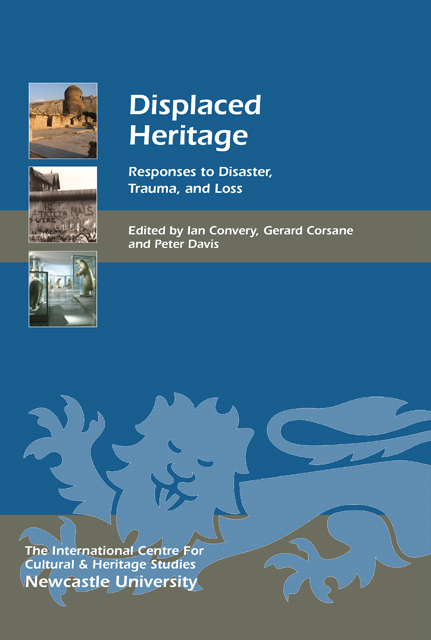Book contents
- Frontmatter
- Contents
- List of Illustrations
- Acknowledgments
- List of Abbreviations
- Preface
- Introduction
- Displaced Heritage: Histories and Tourism
- Displaced Heritage: Trauma, Confinement and Loss
- Displaced Heritage: Lived Realities, Local Experiences
- Displaced Natural Heritage
- Endpiece
- List of Contributors
- Index
- Heritage Matters
22 - Industrial Heritage and the Oral Legacy of Disaster: Narratives of Asbestos Disease Victims from Clydeside, Scotland
Published online by Cambridge University Press: 24 February 2023
- Frontmatter
- Contents
- List of Illustrations
- Acknowledgments
- List of Abbreviations
- Preface
- Introduction
- Displaced Heritage: Histories and Tourism
- Displaced Heritage: Trauma, Confinement and Loss
- Displaced Heritage: Lived Realities, Local Experiences
- Displaced Natural Heritage
- Endpiece
- List of Contributors
- Index
- Heritage Matters
Summary
Industrial heritage up and down the country is carefully preserved in museums, such as at Beamish in North East England, Styal Mills in the North West and the remarkable UNESCO New Lanark industrial village in west-central Scotland. These are nostalgia spaces where we are reminded of the hard graft, craftsmanship, community and camaraderie of work and life as it was. However, relatively little physical heritage survives of the traditional ‘heavy industries’ – the shipyards, iron and steel works and coal mines that once dominated the landscape and economy of whole industrial conurbations. These were places where the simple dignity of human toil was played out every day. But they were also sites of disasters big and small; of dangerous work, of trauma, pain and suffering; of fatal and disabling injuries, poisonous and toxic materials that damaged workers’ bodies; maiming and killing – sometimes quite indiscriminately and obscenely in the pursuit of profit. This has been described aptly as ‘economic violence’ (Bourdieu 1991; 1993). In this context we are most aware, perhaps, of the coal mine disasters (the UK’s largest occurred in Senghennydd in October 1913 with 440 deaths) – usually memorialised by a statue or plaque at the pithead and sometimes the only remaining indication that a thriving pit existed on that spot. These disaster memorials provide a sombre reminder that work could, and did, kill.
Recently scholars of occupational health have argued that definitions of disaster, which have tended to traditionally focus on natural disasters, need to be widened to embrace man-made, technological and socially constructed events, including longer-term insidious physical harm such as that associated with disease as well as ‘accidents’ such as mine explosions (see Mitchell 1996; Tucker 2006; McIvor and Johnston 2007). Such studies rarely, however, utilise an oral history approach based on the systematic interviewing of eye-witness participants (victims, regulators and perpetrators). Nor are the voices of disaster victims integrated substantively in the public history and heritage sector. With some notable exceptions, museums, heritage centres and commemorations do little to evoke the emotional history of disasters; the everyday lives of these workers, their feelings, emotions and cultures; how they navigated their way through hazardous labour processes, calculated risks, weighed options and how their lives were affected by disabling injuries, pain, suffering, trauma and insidious occupation-related industrial diseases and how their families and loved ones coped with their loss.
- Type
- Chapter
- Information
- Displaced HeritageResponses to Disaster, Trauma, and Loss, pp. 243 - 250Publisher: Boydell & BrewerPrint publication year: 2014
- 1
- Cited by



